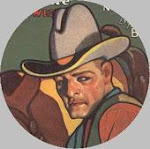
Maynard Dixon is one of my favorite western artists. Maybe he’s just my favorite western artist. (These things change depending on what I’m looking at when I’m saying things like this, of course.) But maybe because his work isn’t so seemingly ubiquitous as that of other artists of the west -- like N.C. Wyeth or Fred Remington or Charlie Russell -- that when I again see a piece by Dixon, I’m just gob smacked.
When I come unexpectedly across a piece of art by Dixon, I’m awestruck by the epic sense it emanates -- like the vast Romantic landscapes of the Hudson School of painters, or the way John Ford used Monument Valley as a backdrop for his western films, or how Aaron Copland so zealously captured the grandeur of the American continents’ scope in his compositions (for the western zest of this distinctly American composers’ music, listen to Rodeo or Billy The Kid, both available on a disc conducted by Leonard Bernstein, available at The Spur & Lock’s Spinner Rack).
I was reminded of my amazement at seeing new (to me) pieces of Dixon art when someone posted a scan of a Sunset Magazine cover on an email group. There was Maynard’s mark, in all his glory. It’s not clear which year this issue was published in, although someone suggested between 1913 and 1915, because Sunset took over Pacific Monthly magazine in 1912, and its title is still incorporated in the logo for the magazine. The juxtaposition of bold colors is the Maynard Mark for me -- and although there may be some folks who remember or collect Herman Whitaker (the author whose novel gets this cover treatment), this Dixon painting is sure to outshine the story.
I first learned about Dixon when I saw his illustrations for an early -- maybe the first -- edition of one of Clarence Mulford’s Hopalong Cassidy novels. I quickly found out he had also illustrated many other books, including some westerns by Dane Coolidge. He later left illustrating for publishers to be a fine artist with quite a career. He became known as The Thunderbird among friends. A century later, Dixon is still illustrating books: A recent Penguin edition of Zane Grey’s Riders of the Purple Sage features a piece of classic Dixon art on the cover.
There are several web sites on Dixon. MaynardDixon.org is a fine one to start. The site’s page on Dixon’s magazine art is a nice followup to the scan I’ve posted with this post. Also nice is a site dedicated to a documentary about Dixon. Visit that site, and you can watch a clip of the film. Very nice.
You can check the Spur & Lock Spinner Rack’s Maynard Dixon category for some items focusing on The Thunderbird.





